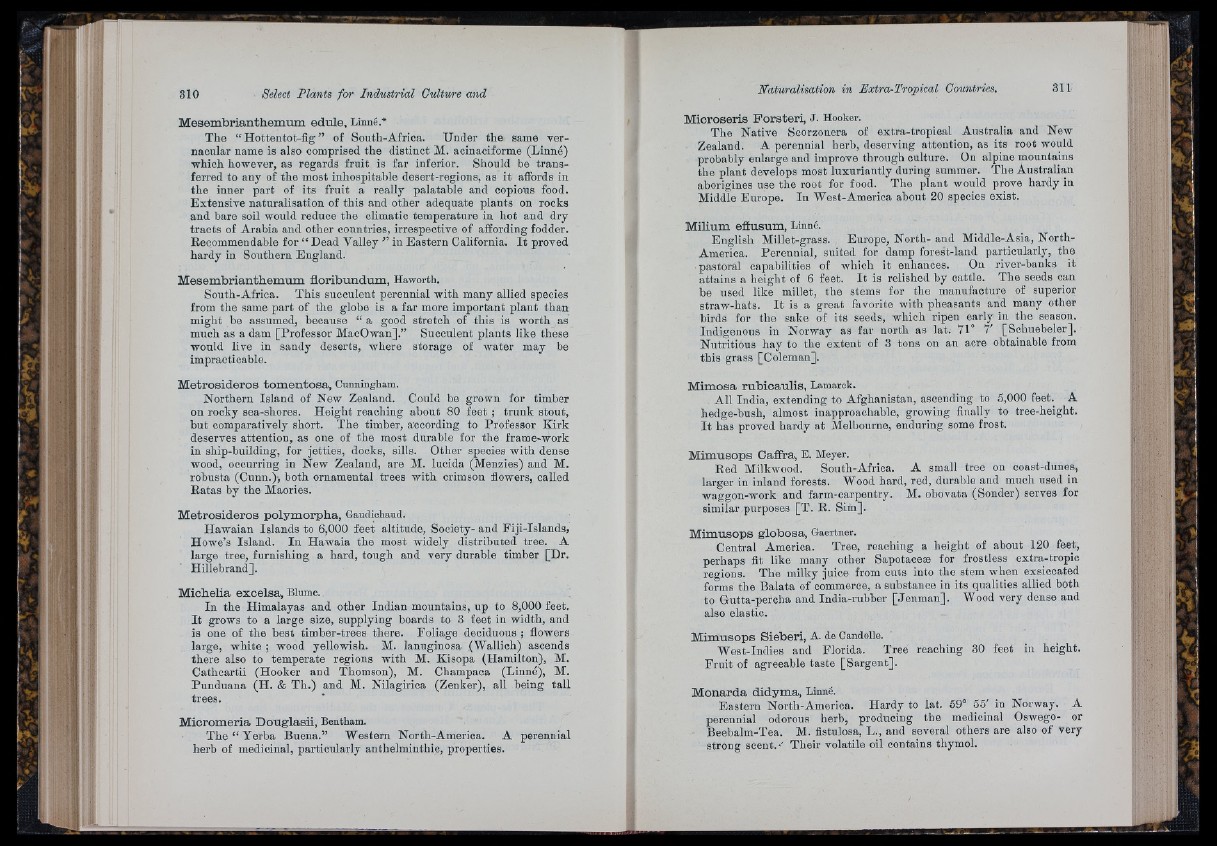
ni fr :
! k :
Mesembrianthemum edule, Linné.*
The “ Hottentot-fig ” of Soiith-Afrioa. Under the same vernacular
name is also comprised the distinct M. acinaciforme (Linné)
■which however, as regards fruit is far inferior. Should be transferred
to any of the most inhospitable desert-regions, as it affords in
the inner part of its fruit a really palatable and copious food.
Extensive naturalisation of this and other adequate plants on rocks
and bare soil would reduce the climatic temperature iu hot and dry
tracts of Arabia and other conntries, irrespective of affording fodder.
Eeoommendable for “ Dead Valley ” in Eastern California. I t proved
hardy in Southern England.
Mesembrianthemum floribundum, Haworth.
South-Africa. This succulent perennial with many allied species
from the same part of the globe is a far more important plant than
might he assumed, because “ a good stretch of this is worth as
much as a dam [Professor MacOwan].” Succulent plants like these
would live in sandy deserts, where storage of water may he
impracticable.
Metrosideros tomentosa, Cunningham.
Northern Island of New Zealand. Could be grown for timber
on rocky sea-shores. Height reaching about 80 feet ; trunk stout,
but comparatively short. The timber, according to Professor Kirk
deserves attention, as one of the most durable for the frame-work
in ship-building, for jetties, docks, sills. Other species with dense
wood, occurring in New Zealand, are M. lucida (Menzies) aud M.
robusta (Cunn.)-, both ornamental trees with crimson flowers, called
Eatas by the Maories.
Metrosideros polymorpha, Gaudichaud.
Hawaian Islands to 6,000 feet altitude. Society- and Piji-Islands,
Howe’s Island. In Hawaia the most widely distributed tree. A
large tree, furnishing a hard, tough and very durable timber [Dr.
Hillebrand].
Miohelia excelsa, Blume.
In the Himalayas and other Indian mountains, up to 8,000 feet.
I t grows to a large size, supplying boards to 3 feet in width, and
is one of the best timber-trees there. Foliage deciduous ; flowers
large, white ; wood yellowish. M. lanuginosa (Wallich) ascends
there also to temperate regions with M. Kisopa (Hamilton), M.
Cathcartii (Hooker and Thomson), M. Champaca (Linné), M.
Punduana (H . & Th.) and M. Nilagirica (Zenker), all being ta ll
trees.
Micromeria Douglasii, Bentham.
T h e “ Yerba Buena.” Western North-America. A perennial
herb of medicinal, particularly anthelminthic, properties.
Microseris Forsteri, J. Hooker.
The Native Scorzonera of extra-tropical Australia and New
Zealand. A perennial herb, deserving attention, as its root would
probably enlarge and improve through culture. On alpine mountains
the plant develops most luxuriantly during summer. The Australian
aborigines use the root for food. The plant would prove hardy in
Middle Europe. In West-Ameriea about 20 species exist.
Milium eftusum, Linné.
English Millet-grass. Europe, North- and Middle-Asia, North-
America. Perennial, suited for damp forest-land particularly, the
pastoral capabilities of which it enhances. On river-banks it
attains a height of 6 feet. I t is relished by cattle. The seeds can
be used like millet, the stems for the manufacture of superior
straw-hats. I t is a great favorite with pheasants and many other
birds for the sake of its seeds, which ripen early in the season.
Indigenous in Norway as far north as lat. 71° 7' [Sclmebeler].
Nutritious hay to the extent of 3 tons on an acre obtainable from
this grass [Coleman].
Mimosa rubicaulis, Lamarck.
All India, extending to Afghanistan, ascending to 5,000 feet. A
hedge-bush, almost inapproachable, growing finally to tree-height.
I t has proved hardy a t Melbourne, enduring some frost.
Mimusops Caffra, E. Meyer.
Bed Milkwood. South-Africa. A small tree on coast-dunes,
larger in inland forests. Wood hard, red, durable aud much used in
waggon-work and farm-carpentry. M. obovata (Sonder) serves for
similar purposes [T. E. Sim].
Mimusops globosa, Gaertner.
Central America. Tree, reaching a height of about 120 feet,
perhaps fit like many other Sapotaceæ for frostless extra-tropic
regions. The milky juice from outs into the stem when exsiccated
forms the Balata of commerce, a substance in its qualities allied both
to Gutta-percha and India-rubber [Jenman]. Wood very dense and
also elastic.
Mimusops Sieberi, A. de Candolle.
West-Indies and Florida. Tree reaching 30 feet in height.
Fruit of agreeable taste [Sargent].
Monarda didyma, Linné.
Eastern North-America. Hardy to lat. 59° 55' in Norway. A
perennial odorous herb, producing the medicinai Oswego- or
Beebalm-Tea. M. fistulosa, L., and several others are also of very
strong scent."' Their volatile oil contains thymol.